Editor’s note: The Wake Forest Magazine team conceived this photography issue in part to pay tribute to Ken Bennett, above. Over nearly three decades, he documented the iconic places and events on campus and the ever-changing expressions of our students. He developed friendships with faculty and staff, insisting on making anxious teacher-scholars feel at ease during photo shoots when they preferred to be anywhere but in front of the camera. He wore out his knees in the process of lugging equipment and shooting photographs, but don’t worry, Ken at 62 has a new set for hiking mountains in his next chapter.

How did he end up working at Wake Forest? His wife read a want-ad in the Sunday newspaper in Richmond, Virginia, and Ken traveled to Winston-Salem for the interview. He liked what he saw but thought, “Huh, I wonder where the rest of the campus is?” He knew Wake Forest was a successful member of the Atlantic Coast Conference, and perhaps understandably, he thought the University must be another 60,000-student, public school. Wrong.
Surprised but undeterred, he was destined to learn every nook, cranny and tradition of the smallest school in the ACC.

Of the 190,000 images in the University’s digital photo archive, a repository Ken created around 2000 or 2001, Ken figures he shot 90% of them, including the images with this piece. He has won numerous awards, including Master of the Profession from the University Photographers’ Association of America (2013); Photographer of the Year — Gold Award — from the Council for Advancement and Support of Education (2014) and Wake Forest’s Employee of the Year in 2015.
Early in the spring semester, he talked with editor Maria Henson (’82) about his career, but don’t expect to read about his pick for his top-ranked photo or his favorite Wake Forester to photograph. He’s carrying those secrets into retirement. Excerpts that follow have been edited for brevity and clarity.

Maria Henson: Tell me about your first day on the job.
Ken Bennett: January of 1997. I still have the first photo that I made. My first assignment was a portrait of a group of faculty musicians, and there were some from Wake and some from the (University of North Carolina) School of the Arts. It was a concert ad for the music of (Franz) Schubert. …
I remember it was late afternoon, early evening, and I had my giant container of lighting equipment and went down there. And, of course, I’d never photographed in Brendle Recital Hall. I’m trying to figure out how we’re going to set this up, how we’re going to light it. We’re shooting slide film, so it has to be lit with big strobe units. I used to carry hundreds of pounds of lighting gear because we were shooting slow slide film. Photo turned out pretty well.
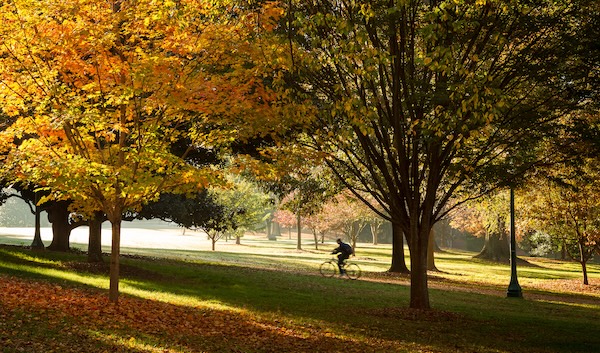
MH: How did you get started in photography?
KB: My father was a very enthusiastic amateur photographer. When I was in elementary school, we had a dark room in the basement of our house. And I found that fascinating. The whole dark-room thing, film photography and getting in the dark room and making prints and watching them in the developer as they come up. It’s magic. It truly is magic.
We moved when I was in middle school, and we didn’t have room for a dark room in the house. I got into other stuff. I got into debate. I got into music, playing in the orchestra, did a lot of theater. Debate was my huge passion in high school.
•••
He talks about his time at William & Mary, when he discovered his passion for economics, took some time away from school, returned and married his girlfriend, Nora Ann. Ken’s father gave him a camera as a wedding gift. At college again, Ken immersed himself in photography. He frequented the dark room in the student union basement, and in the bookstore and library, he pored over photography books about professional luminaries such as Henri Cartier-Bresson and brothers David and Peter Turnley.

After graduating in 1987, he worked for a year and a half at The Virginia Gazette in Williamsburg, Virginia. He then became a freelance photographer in Richmond, fulfilling assignments for The New York Times, The Washington Post, corporate clients, trade magazines and The Associated Press. There he found a hard-driving, exacting mentor in Steve Helber, the AP Richmond bureau’s lone staff photographer then.
“Steve made me a photojournalist,” Bennett says. “He kicked my (behind) for nine years.”
•••
KB: Steve would always say, “Shoot what’s in front of you.” And that’s the key. It is the very Zen-like, wash-your-bowl sort of advice, right? Start shooting. Shoot pictures. Make pictures. If you wait, you’re missing things. … It seems very simple, but a lot of people are trying to figure out what they’re supposed to shoot here, but you need to just shoot what’s in front of you. …
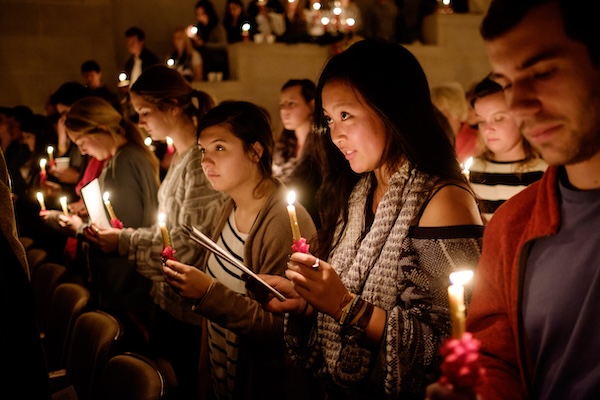
If you’re at (an event), and everybody’s watching something, turn around and take pictures of what’s behind you. What does the crowd look like that’s looking at this particular thing that’s happening? …
You pick up the Cartier-Bresson stuff about the (decisive) moment. Light, composition and moment. That’s what you’re looking for. That’s the trifecta for photojournalists. You want really great light. You want to compose it well while you’re waiting for that moment to come together: There’s the expression; there’s the gesture. It’s different for every assignment.

MH: What would be a perfect Wake Forest day of shooting photos?
KB: My favorite assignments at Wake Forest are always freshman move-in day and Commencement. They are the bookends for the year. … The incoming freshmen were happy. They hadn’t been crushed by the weight of responsibility of going to class yet. Their parents were happy. Then you’ve got four years of a fairly tough education, and then you’ve got Commencement. …

Farrell Hall under construction

Farrell Hall's completed lobby
If I had to talk about the perfect day, Commencement photography would be it. It was always my most enjoyable day of work. It’s a lot of work. … You’re shooting 3,000 raw files and carrying two or three cameras, and you’ve got to get some kind of coherent story of 200 photos that we’re going to upload and use in a lot of different places.
- A professor and a graduate hug at Wake Forest’s commencement ceremony in 2017
- Students at commencement ceremony with Wait Chapel in the backdrop. 2016
MH: People recognize that you always find a solution. When it rained at a couple of Commencements, you could have put down your camera in despair. You didn’t.
KB: Nope. That was fun. Best pictures I ever made. But again, that was serendipity, right? My whole career has been serendipity.

The late University Chaplain Emeritus Edgar D. Christman ('50, JD '53, P '84, '85), who died on Christmas Eve, 2014
MH: But why is it serendipity when someone else might have said, “Oh,
my gosh. It’s raining, and now I am so up a creek?”
KB: Good question. That’s “shoot what’s in front of you.” That’s all you can do. I do remember that (first rainy Commencement) day. It was raining so hard early on that we went to the Joel (coliseum). It was actually kind of nice. One of the cool things about the Joel, you can get up on the catwalk and make pictures (looking) down, which was kind of fun. But the lighting’s terrible. …

(At 2013 Commencement), I had my iPhone. I’m looking at the radar, and you can see this giant storm cell, and I’m showing it to people on the stage. They’re reading a name every four seconds. Then it’s every three seconds. Students are going across the stage. (Administrators, he says, were thinking), “We can do it. We’re going to make it. We’re going to get everybody out of here.”
And, of course, they didn’t. As the students are trying to line up (and walk through the faculty congratulatory gantlet), the skies just opened up. … It was a huge challenge to make great photos, but it was also fun to make great photos.

MH: You talked about the magic of developing film in your father’s dark room. How did that assessment change as you moved into digital photography at Wake Forest?
KB: It’s still magic. It’s still photography in a different way. I went from shooting 150 or 175 assignments a year to like 700 assignments a year. And you can have the photos today. I shoot them for the next day, and boom, we’re done. And by the way, the quality of the photos is so superior — the quality of the color, the quality of the images themselves. … By 2005, the image quality was so good that nobody would go back to film.

- A student lies on the “Periodic Table Table” picnic table near Salem Hall while reading.
- Dancers performing at Wake Forest
MH: Tell me about your style of photography and whether it’s changed
over the years.
KB: It’s hard to figure out your own style. I think the most important thing for me, especially with portraiture or anything where people are involved, is building a rapport with the subject. … And let me tell you, coming to Wake Forest made that so much better. … You can really have a much better relationship with your subjects in a place like this.

The late Professor of Russian Billy Hamilton (P '94, '98), who died in 2021
MH: How did you get people to feel comfortable in front of the camera?
KB: I feel like one of the things I’m pretty good at is finding some connection with someone, someplace that we share, a hometown. We share basic humanity if nothing else. You don’t go in and start taking pictures. You go in and sit down and have a conversation, and that conversation can sometimes take a very long time. … A lot of faculty members are very uncomfortable in front of the camera. The key is to be very gentle with people and have them understand that my goal is for them to be happy with the photo. This is not gotcha journalism.
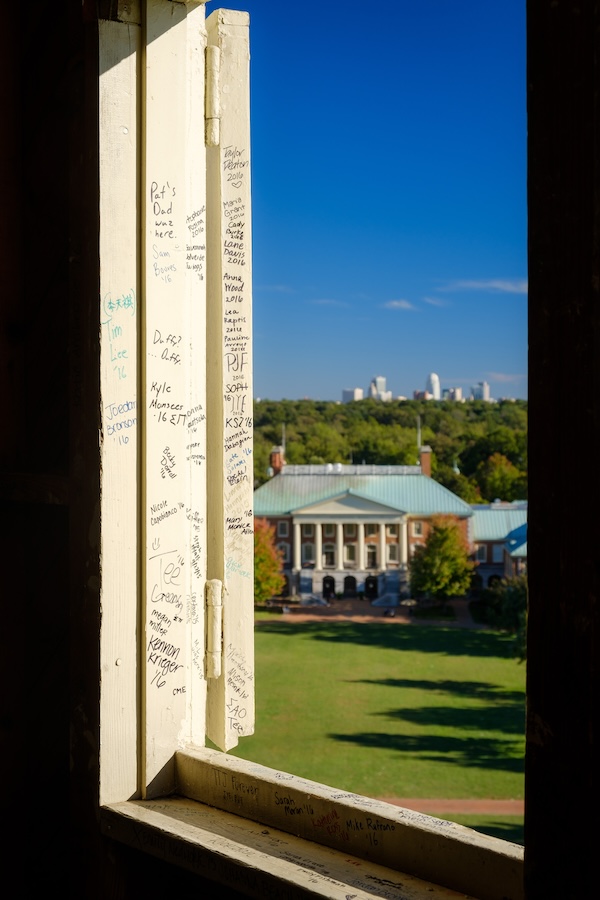
MH: I remember talking with you about how much you liked to get up early in the morning to photograph.
KB: Yeah, I miss that. I haven’t done that in a while. … Especially in the winter, the winter light is amazing. I would just grab cameras and go looking for pictures on campus, and I loved that. If it was a crappy day, I’d come into the office and get work done before anybody else showed up.
On this campus, morning light is special.
MH: Why?
KB: I think it’s the angle. It’s where the sun comes up over the Quad. The morning light pops up and hits the front of the chapel and just pops a little bit over those trees next to Reynolda and just rakes across the top of the chapel. … I can go out there like a half-hour before the sun comes up and the chapel’s still lit, and if there’s some decent clouds in the sky, you can get some really nice-looking, pre-dawn light. Or you can be back behind the chapel and get it silhouetted with the sun coming up.
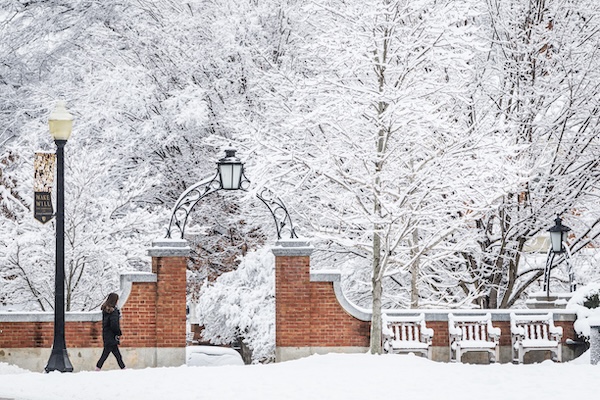
MH: How did you not grow tired of taking photos of Wait Chapel? Or did you?
KB: It’s always different. The light’s different. The weather’s different. If I lived in Paris and I was taking pictures of Notre Dame, I would never get tired of taking pictures of Notre Dame or the Eiffel Tower, because it’s always different.
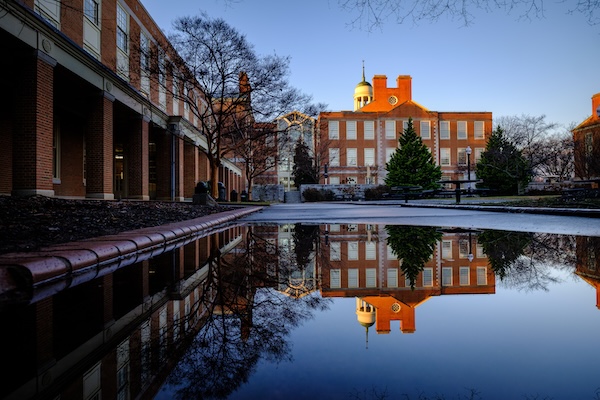
MH: Did you feel in your 27-year career that you had places that really meant something to you as a photographer and member of this community?
KB: We’ve talked (before) about the library. It has been for the longest time the social hub of the University. I mean, I went to school where people avoided the library at all costs. (Here) it’s always been a really great place to find photos. (It’s) actually one of the places where the afternoon light is better.

The library atrium … is amazing. There’s always something going on there, whether it’s some poor student crushed under their workload or really great light. They’ve had a series of coffee shops in there that have been fun to find photos or make portraits of people. … The cupola is instantly recognizable. … It’s just a really nice-looking place, and the people over there are terrific.
MH: What would you say to people about your time at Wake Forest?
KB: I’ve been really lucky to do this — to push a little button for a living. Do something that fulfills me creatively and have somebody pay me for it? That’s pretty unusual.
- Students walk across sidewalk on top of chalked text of the Wake Forest Fight Song
- A basketball game in 2010. Tie Dye Wake Forest logo hangs off the scoreboard.
MH: What do you have in mind for retirement, and will photography be a part of it?
KB: I don’t really have any interest in freelancing anywhere. Our daughter lives in New Mexico, so I’ve done a lot of travel out West, and on a fairly regular basis something will strike me that I really want to photograph, and I’ll spend a lot of time and effort trying to make good photographs. I love landscape work. …
My wife and I play old-time music — fiddle and banjo — and there are people to play with all over the country. We’re going to travel around the country in our camper and make photographs and do some hiking and play tunes with people and enjoy our lives.
MH: You deserve it.









